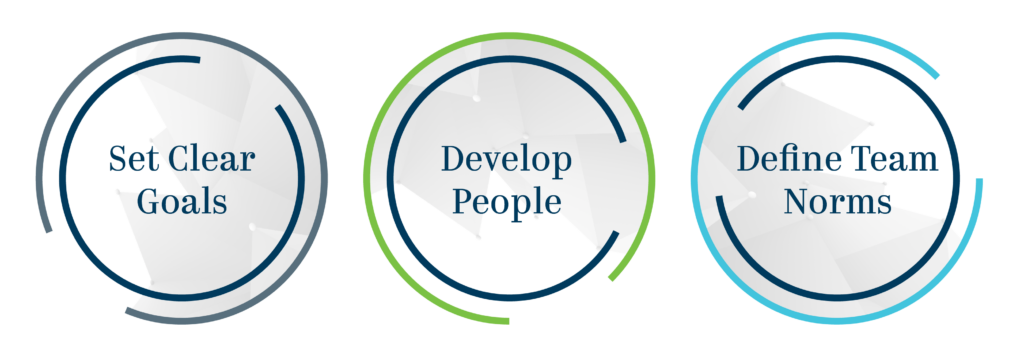By Erika Andersen, Founder/Partner
We subscribe to the principle that each individual is responsible for their own performance and development. But we also know from over 30 years of observing leaders in action how uniquely positioned a leader is to support employee growth and performance. This is even more true as hybrid work is more widely adopted. The essentials are: goals that are clear, compelling and agreed-upon; meaningful development; and effective and agreed-upon ways of working that make achieving the team goals easier.
Changes to the Hybrid Work Environment
The pandemic forced widespread adoption of hybrid work, but a mix of working in-office and working elsewhere is not new. We’ve worked with hybrid and remote teams since we started the firm in 1990. Today’s technology mitigates most—but not all—of the traditional downsides of working at a distance.
In the past, remote workers were outliers, and many organizations took an “out of sight, out of mind” approach to remote or hybrid work. If someone wasn’t present in the office, they were responsible for staying engaged, finding their own opportunities, and keeping up to date on projects themselves.
Now, employees have higher expectations for organizational norms around remote and hybrid work. They’ve seen what’s possible with remote and hybrid work environments, and they want to be supported, regardless of how they work. In turn, leaders are positioned to alter how they collaborate with their teams to meet—and exceed—expectations.
Rather than resist these changing expectations, embrace them with our three timeless tips.
3 Tips for Leading in a Hybrid Work Environment
Start adapting to hybrid work by reflecting on how fulfilling your leadership responsibilities might look different in this changed environment. Based on our experiences supporting, our top three tips are: set clear goals, develop people, and define team norms.

1. Set Clear Goals
Alignment on goals is always vital to reaching milestones. It can be more challenging to align in a hybrid environment.
Focus on clarity and simplicity when setting expectations for team members, so all parties feel valued, successful, and energized. Ask yourself, “Does everyone understand the outcomes we’re working toward and the most important thing to be doing at any given time?”
Establish clear(er) expectations team-wide by:
- Setting 2–3 priorities and deprioritizing around those priorities;
- Describing what success looks like—short- and long-term—and regularly communicating that vision to the team;
- Frequently communicating goals aligned to the priorities, as well as the key deliverables and deadlines;
- Using a variety of communication channels to reach everyone;
- Asking team members to tell you the priorities and goals to verify everyone is aligned; and
- Simplifying processes, standardizing where possible, and reducing unnecessary escalations for decision-making.
These activities will look different depending on your work. For example, a professional services client struggled to meet its key performance indicators (KPIs) once teams switched from being together in an office to being hybrid. They had KPIs, including tasks completed, but those measurements of success were not clear indicators of employee performance or quality of work.
After switching to a hybrid work environment, leadership recognized teams were showing uncertainty about what was expected of them. We facilitated a collaborative session to align on KPIs, like quality of work and account health, that better measured success for the company’s new work style.
2. Develop People
Consider the metaphor of a sports coach, used so often to describe a leader’s role as an agent of growth and performance. How many coaches have you seen working at a distance from their team? Not many! It’s not surprising that employee development can be challenging in a hybrid work environment.
Reflect on your exposure to different team members—are they usually in the office, sometimes in the same place, or always remote—and how that influences the time and ways you invest in their development. In most cases, there are opportunities to better tailor your coaching approach to meet employee needs for more equitable development.
In order to develop team members more effectively, consider:
- Team members’ motivators, stressors, and preferences so you can be flexible and empathetic to their needs;
- How to evaluate performance relative to outcomes or KPIs, rather than attendance, availability, or visibility;
- Plan coaching sessions ahead of time (especially when you’ll be in the same locations as hybrid and remote members of your team) and share objectives in advance; and
- Structure conversations so you cover all the bases: Build rapport, recognize progress and successes, discuss growth opportunities, and align on next steps.
Tactically, this can take the form of consistently revisiting development processes or professional development plans to ensure all team members are being developed according to their goals.
For example, a manager in a technology company asked each member of her team to create a personal development plan with objectives for growth and milestone goals for tracking progress. Then the manager set aside time in one-on-ones to check in on progress, and coached team members through any challenges that arose. This approach gave the manager an opportunity to learn and adapt to preferred methods of development and hoped-for career trajectories.
3. Define Team Norms
Align on team expectations and collaborate to understand how everyone will contribute to fulfilling them through their work, communications, and habits. Once that is clear, you and your team can have more direct conversations on the specific norms in the hybrid work environment that will allow everyone to work most effectively.
Make it easy for everyone to share their preferences and opinions with questions like:
- How do you prefer to collaborate? Why?
- How can we use technology to collaborate well in a hybrid work environment?
- What are the team’s collective goals and responsibilities? Who is responsible for what?
- When are team members expected to be available for work or in the office? When will team members be offline?
Collaborate to agree to standardized answers, then develop the agreed-upon answers into team norms. Finally, with your team, answer the question, “Are we clear on what’s expected of each member of this team?”
Share the agreed-upon norms widely and across multiple communication channels, so everyone knows the expectations. “Practice” the norms for a defined amount of time, then review and adjust with the team as needed.
In a hybrid work environment, teams that aren’t aligned on team norms are less likely to be successful. For example, leaders at a telecommunications organization had existing expectations for team members but didn’t reassess those ways of working for a hybrid work environment. Some team members started work earlier in the day, then were unavailable in the evenings, while others started later and worked later; people used Microsoft Teams differently; everyone operated in a silo of their own preferences.
The team met and answered the above questions together. Once everyone shared their perspectives, they found solutions to meet everyone’s needs. The team established norms related to working hours, the use of different virtual platforms, and more. The team also agreed to revisit the norms with major organizational changes, like team growth, revenue changes, or a return to in-office work.
By ensuring team-wide alignment, everyone had a more accurate understanding of how to participate, what to expect of one another, and how to hold one another accountable for building their collective ideal work environment.
How to Incorporate These Tips in Your Workplace
As a leader, facilitating adjustments to a hybrid work environment will build trust and enhance collaboration. By committing to regular self-assessment and improvement, you will ensure your team remains strong over time, no matter where and how they work.
We’ve found our approach to developing and sustaining high-performing teams is timeless and applies to organizations of any size, maturity, or industry. If you’re looking for ways to make organizational improvements, including supporting hybrid teams more effectively, we can help.







